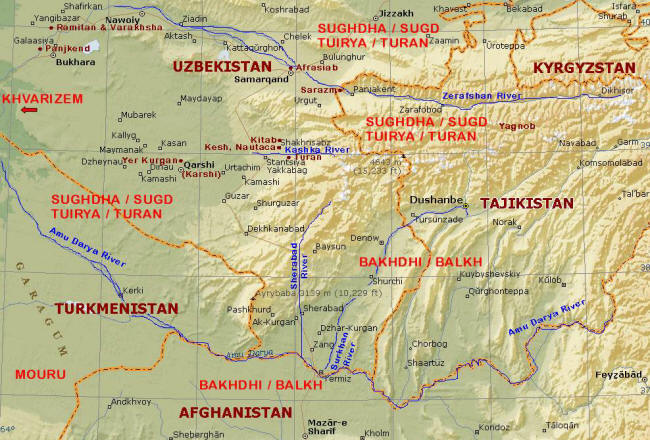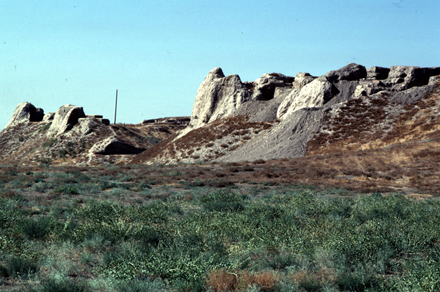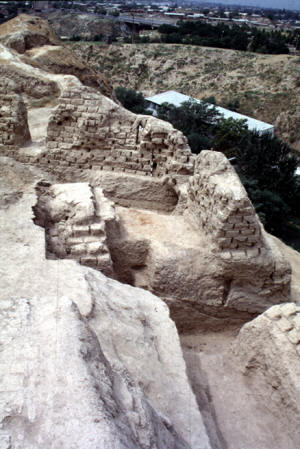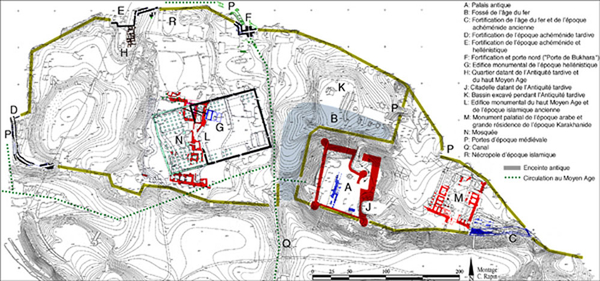
| SUKHDHO / TUIRYA Turan
:
Later it history, the location of Airyana would move westward, and became the middle Aryan / Iranian kingdom of Airan Vej, the Iran of Ferdowsi's Shahnameh. We will call this middle Aryan / Iranian country Airan. At this point in history, the northern half of the Amu Darya or Oxus River formed the border between the Aryan lands of Airan and Turan. Both neighbours would eventually undergo a name change. While Airyana Vaeja changed its name to Iran, Turan became Sughdha and then Sugd (Sogdiana to the Greeks).
As with many ancient lands in the region, a country had a principal river that ran through it and in whose valleys the bulk of the population resided. For Turan, that river appears to be the river called Zerafshan today - a river that runs through the modern countries of Tajikistan and Uzbekistan.
Nowadays, the lands of ancient Turan and Sugd have been divided between Tajikistan and Uzbekistan since the people in the Tajik portion are predominantly the descendants of the older Indo-Iranian peoples, the Turanians or Sogdians, while the people in the Uzbek portion are mainly the Turkic Uzbek peoples - relatively recent (in the last two thousand years) occupants of the land - invaders from the north-east who displaced the original Indo-Iranian Turanian / Sogdian inhabitants as well as Turan's north-western Saka neighbours.
Map of Turan / Sugd (Tuirya / Sughdha) Turan
- Avestan Nation :
Turan and its love-hate relationship with Airyana Vaeja's successor nation, Airan Vej, has since become the stuff of folklore and legends - legends that the poet Ferdowsi recounts his epic, the Shahnameh.
[As we had noted earlier, we will use the name Airan to identify the middle Aryan nation that succeeded Airyana Vaeja, and one that preceded Iran with Persia at its centre. The change in name also represents a westward geographical shift in the location of the middle Aryan nation's centre. Airan would have been a confederation of kingdoms, with the principal kingdom and capital being Balkh. According to Ferdowsi's Shahnameh, to travel from the Airanian state of Balkh to Turan, one had to cross the Jihun or Amu Darya, travelling east and north.]
Turan's Connection to Sughdha (Sugd) :
By the time Ferdowsi wrote his monumental epic, the land of Sugd had been occupied by a Turkic people, and Ferdowsi understandably equated the Turanians with Turks. However, with the benefit of modern research, we know that the Turkic peoples were relatively recent (within the last two thousand years) arrivals to the area. The Turkic migrations were not peaceful. The Turkic peoples forcible occupied the land and displaced the original Indo-Iranian Turanians / Sogdians.
The identification of Turanians with Turkic peoples has led to all kinds of complications - complications that are unnecessary for the most part. The twentieth century saw western linguistics and academics renaming the desert lands and steppes around the Caspian Sea as Turan, and in the process greatly confusing the original application of the name and in the process creating the added problem of trying to distinguish the Turkic peoples from the Scythians and the Saka.
The Turanian were an Avestan people. They spoke a proto Indo-Iranian language and not a Turkic language. In the Avesta, Turan is mentioned over twenty times and the Avestan references show no ethnic difference between the Tuirya and the Arya, both having common names and a related genealogy. The kinship between the two groups that existed before the coming of the Turkic tribes, is recounted in Ferdowsi's Shahnameh, where the rulers of Turan and Airan: Tur and Iraj were brothers. Vestiges of the ancient relationship and kinship between Turan and Airan can be found in the Persian language - Turandokht, a popular female Iranian name, means daughter-of-Turan.
Turan's Relationship with Airan (Ancient Iran) :
According to the Shahnameh, during the reign of legendary King Feridoon, the kingdom of Airan had grown to become an empire that included kingdoms from present day Turkey in the west to the Indus valley in the south - lands that approximate the extent of the sixteen nations of the Vendidad. Feridoon decided to divide his sprawling empire the amongst his three sons. To his eldest son Tur, he gave the eastern lands - a nation that came to be known as Turan, named after its appointed king. To his son Iraj, Feridoon gave Airan and Hind (the Indus lands). To his son Salm, Feridoon gave the remaining western kingdoms. Tur, however, felt that as the eldest son he had been slighted, for the lands of Airan and Hind were the gems of the empire and the seat of its power. No sooner had Feridoon divided his kingdom, that the jealous and ambitious Tur persuaded Salm to join him in a plot to murder Iraj. Iraj is killed but not before his wife is pregnant with their son, a son who would later avenge the murder of his father.
As with a number of legendary myths, there lies embedded in them kernels of history. In Ferdowsi's legends, if we replace the Airan empire with the Airan people, this myth tells us that the Airan people had spread to present day Turkey in the west, the Indus valley in the south, to the borders of China in the east and the deserts of the north. This is entirely consistent with the list of nations in the Zoroastrian scriptures, the Avesta's Vendidad. As with the Vendidad list, the whole area consisted of a number of kingdoms. The people in these kingdoms who were of Aryan origin in particular, or Indo-Iranian generally, were kin but nonetheless autonomous people, sometimes independent and sometimes part of an empire dominated by one of the different members of the family. Their frequently internecine warfare, rebellion and jockeying for power is reflected in the Shahnameh's story about Feridoon's sons.
In Ferdowsi's tale, it is also telling that the eldest brother Tur was stationed in Turan, the second oldest in Airan, while the youngest was stationed in the far west. This would appear to be the order of migration of the Airanian people to the west and south. As with the older brother Turan's jealously of being subject to his younger brother, it must have been galling for the Turanians to become a vassal state of Balkh, a younger state that had become the centre of the Airanian nation.
In Ferdowsi's legend, after the death of Iraj and Feridoon, Airan is briefly dominated by Turan. History tells us that the eastern kingdoms of Sugd (Turan's successor kingdom) and Chorasmia, while Zoroastrian by faith, moved in and out of Airan (and Persian) control, sometimes a subservient state to Airan, sometimes independent and at other times the dominant of the two kingdoms.
Afrasiab :
A view of the walls of the Kala-e Afrasiab In the legends of Ferdowsi, a descendant of Tur was the great mythical king Afrasiab (also spelt Afrasiyab, Afrosiab, Afrosiyob), a king who became Iran's nemesis. In the Pahlavi text, the Bundahishn, Afrasiab is mentioned as Tur's seventh grandson.
The Avesta calls Afrasiab Franrasyan and in later Pahlavi texts, his name changes to Frasiyav, Frasiyak and Freangrasyak. Zoroastrian texts give Afrasiab the epithet mairya meaning deceitful or villainous. Siab is said to derive from the Persian siah-ab meaning black water.
A close-up of the walls of the Kala-e Afrasiab :
Kala-e Afrasiab, the Fortress of Afrasiab In mythology, Afrasiab is said to have lived in a subterranean fortress made of metal, called Hanakana.
Today, the ruins of a fortified township located on the eastern heights above Samarkand, bear his name, namely, the Kala-e Afrasiab or the Castle of Afrasiab. The name Kala-e Afrasiab appeared in written sources towards the end of the 17th century CE.
The Kala-e Afrasiab has been identified as the ancient capital of Turan and Sugd, and its construction is dated around 2,000 BCE (uncertain). As with a number of ruins in this region, they often sit on top of older ruins waiting to be discovered. The fortified township is about 220 hectares in area.
By the 7th to 6th century BCE, the Achaemenian Persian empire had expanded to include Turanian / Sogdian lands, and the Achaemenians made Afrasiab as a principle administrative centre of their Eastern empire. Together with Fergana Valley, the environs around Afrasiab would have formed the eastern-most extent of the Persian empire and their fortifications would have guarded the empire's eastern flank. The township built around the oasis below the fortress would grow to become the city of Samarkand (Marcanda / Maracanda in Greek or Macedonia texts) and the centre of the Sogdian culture described further in our page on Sugd, Uzbekistan.
Layout plan of Kala-e Afrasiab fortified township
Source :
http://www.heritageinstitute.com/ |



